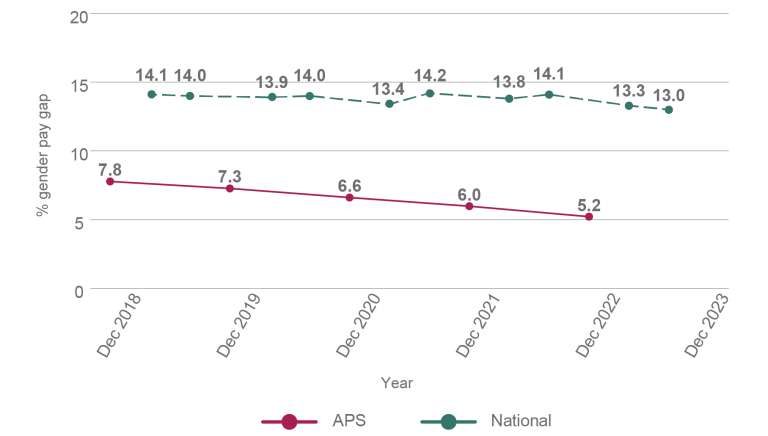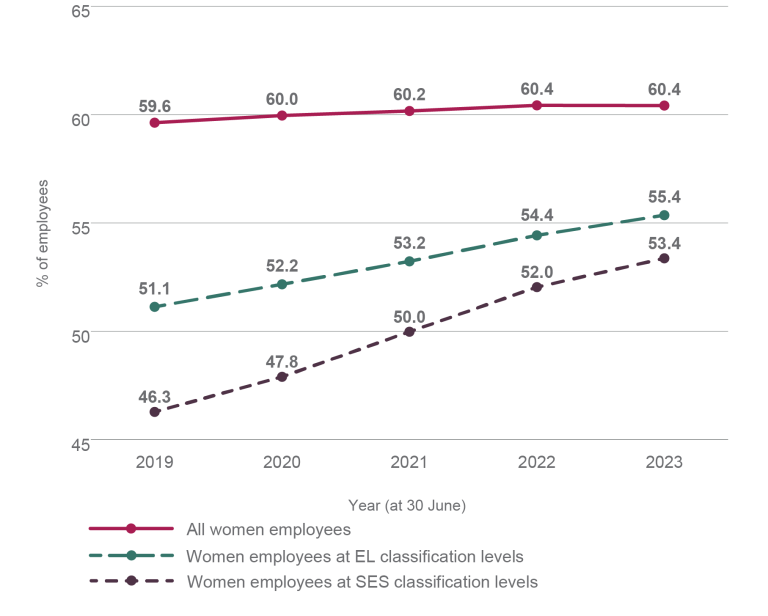Gender equality in the APS

The Australian Public Service achieved its lowest-ever gender pay gap in December 2022, at 5.2% (Figure 2.3). This is less than half the national gender pay gap.
Figure 2.3: Average gender pay gap trends (2018 to 2023)

Source: APS Remuneration Survey (2022), Workplace Gender Equality Agency (2023)
Since 2018, the APS gender pay gap has narrowed from 7.8% to 5.2%. This reduction is being driven in part by more women employees at executive and Senior Executive Service levels. In June 2023, women were in 55% of Executive Level roles, compared to 51% in June 2019. Women were also in 53% of SES roles in June 2023, compared to 46% in June 2019 (Figure 2.4). For the first time, women reached gender parity at the SES Band 2 level.
Figure 2.4: Female employees in the APS (2019 to 2023)

Source: APS Employment Database (APSED)
Research by the Australian Public Service Commission shows that the pay gap persists due to the distribution of women and men across the classification structure, and the predominance of women at APS 3 to APS 5 levels. Further investigation is underway to better understand factors that may be associated with this pattern. This includes examining the type of work being undertaken at these levels and the location of certain jobs.
A key reform to drive transparency and action in relation to the national gender pay gap is mandatory reporting. Australian Government agencies have been required to participate in gender equality reporting from September 2023. From 2024, gender pay gaps of Australian employers with 100 or more employees will be published by the Workplace Gender Equality Agency. This includes individual APS agencies.
The gender pay gap is one indicator of possible gender inequality. Reducing the incidence of discrimination, harassment and unfair treatment is critical in enabling women to achieve equality in the workplace. From 12 December 2022, the Anti-Discrimination and Human Rights Legislation Amendment (Respect at Work) Act 2022 came into effect. The Act provides increased protections for workers from these behaviours, as recommended by the Australian Human Rights Commission following its inquiry Respect@Work: National Inquiry into Sexual Harassment in Australian Workplaces.
The APSC is partnering with Attorney General’s Department, the Australian Human Rights Commission and Comcare to provide agencies with information on current and impending legislative requirements. Resources and tools have been developed to support agencies in creating safe and respectful work environments.
Other Australian Government initiatives in support of gender equality include introducing protocols to support agencies to develop gender-responsive budgets and applying gender impact assessments when developing policy. Initiatives also include the:
- review of the Maternity Leave (Commonwealth Employees) Act 1973
- creation of a Gender Data Asset Register by the Office for Women
- implementation of the APS Gender Equality Strategy 2021–26 and gender-based budgeting.
See also
Appendix 1 – APS workforce trends, State of the Service Report 2022–23
Appendix 2 – State of the service additional data, State of the Service Report 2022–23
Working in the APS – Review of the Maternity Leave Act, State of the Service Report 2022–23
Australian Government (n.d.) APS Gender Equality Strategy 2021–26, APSC website, https://www.apsc.gov.au/publication/australian-public-service-gender-equality-strategy-2021-26, accessed 5 October 2023.
Australian Government (n.d) Drivers of the 2021 APS Gender Pay Gap April 2023 Research Note 03-23, APSC website, https://www.apsc.gov.au/sites/default/files/2023-04/Drivers%20of%20the%202021%20APS%20Gender%20Pay%20Gap.pdf, accessed 5 October 2023.
Australian Government (n.d) Fact Sheet: Respect@Work Changes to the Sex Discrimination Act 1984 and the Australian Human Rights Commission Act (December 2022), AHRC website, https://humanrights.gov.au/our-work/complaint-information-service/fact-sheet-respectwork-changes-sex-discrimination-act-1984-ahrc-act-1986-december-2022, accessed 5 October 2023.
Australian Government (n.d) Workplace Gender Equality Agency Get future ready: A guide to understanding changes to WGEA's legislation, WGEA website, https://www.wgea.gov.au/about/our-legislation/Closing-the-gender-pay-gap-bill-2023, accessed 5 October 2023.



